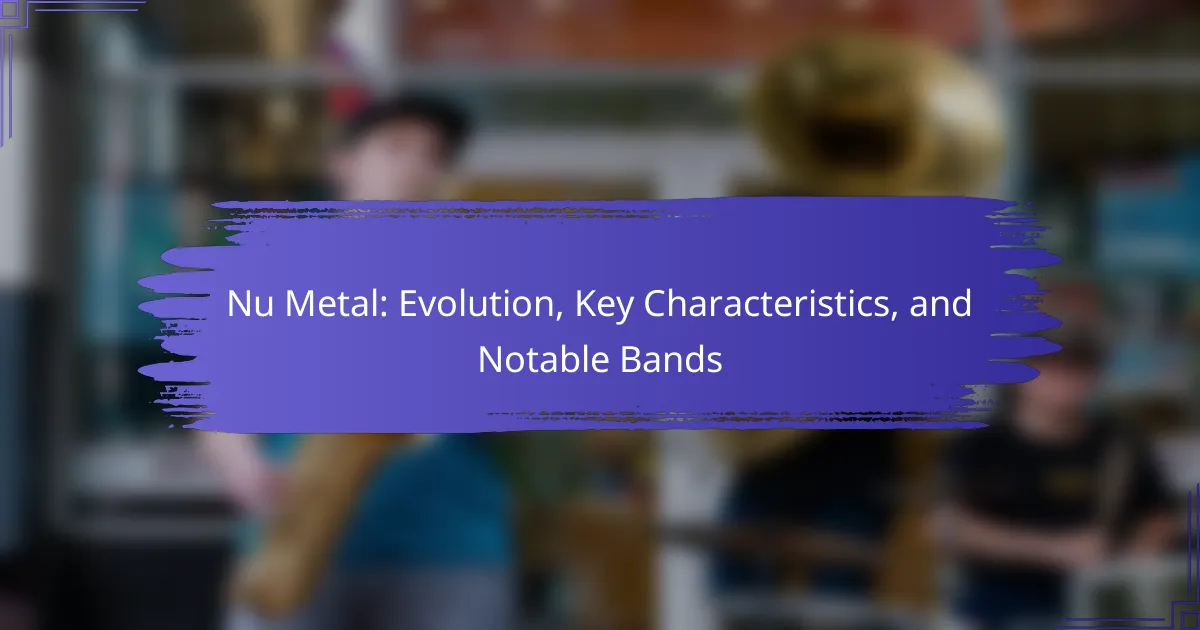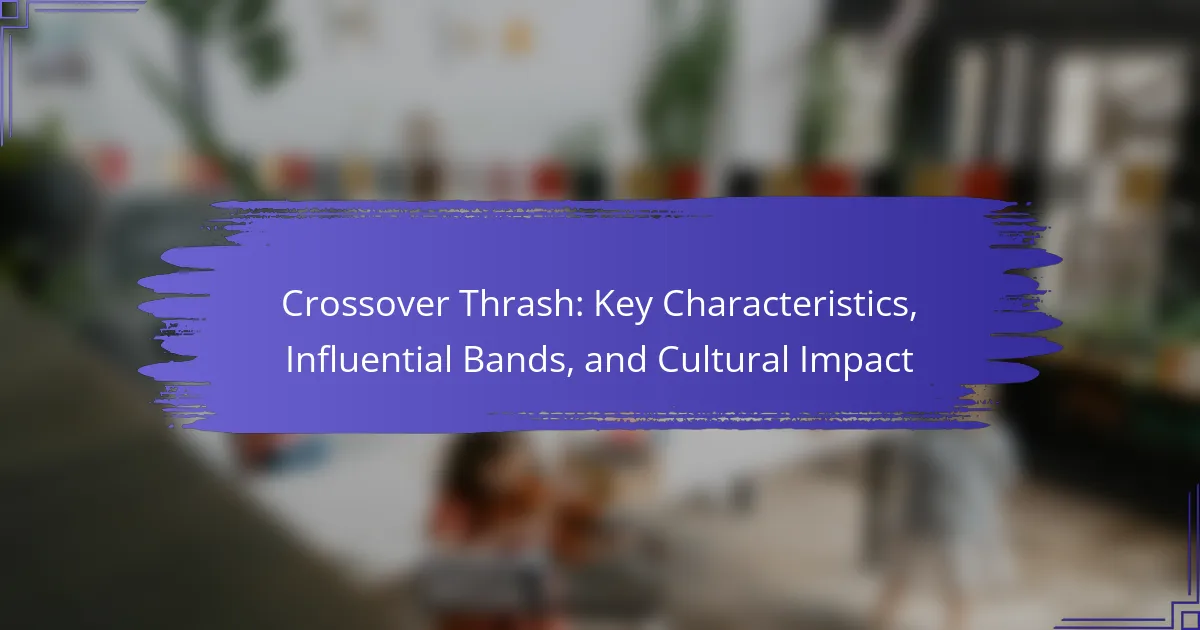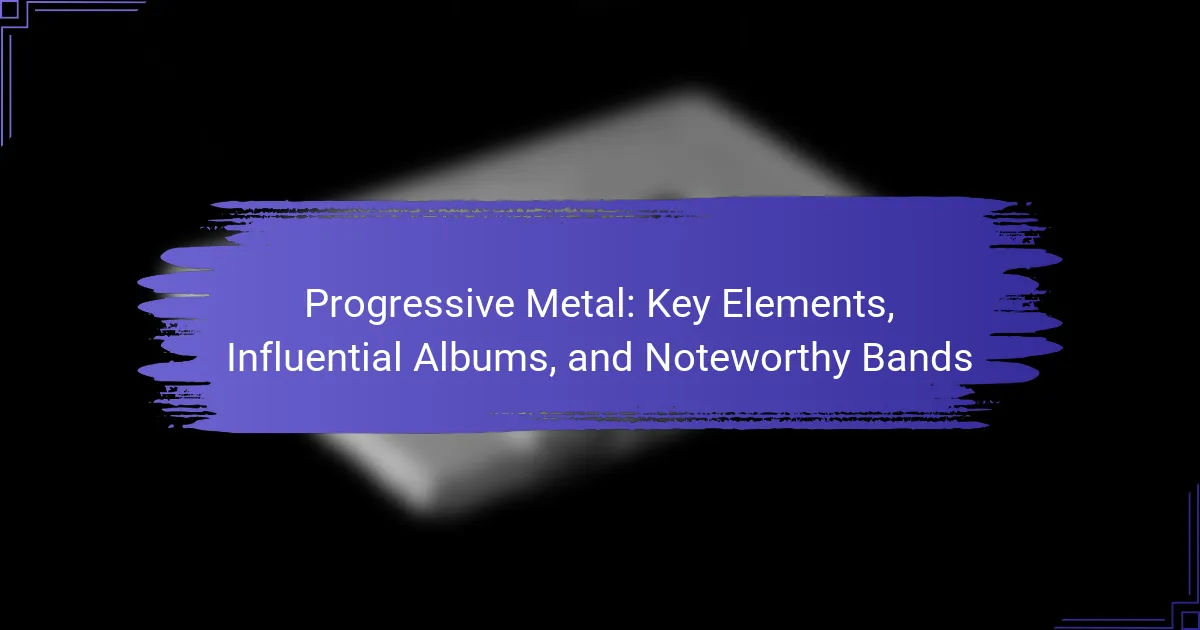Doom Metal captivates listeners with its heavy riffs and dark themes, rooted in the music of the late 1960s. This article explores its history, iconic albums like “Black Sabbath” and “Dopethrone,” and the genre’s regional diversity. It also examines the challenges artists face in today’s evolving landscape and the vibrant community that supports this unique sound.
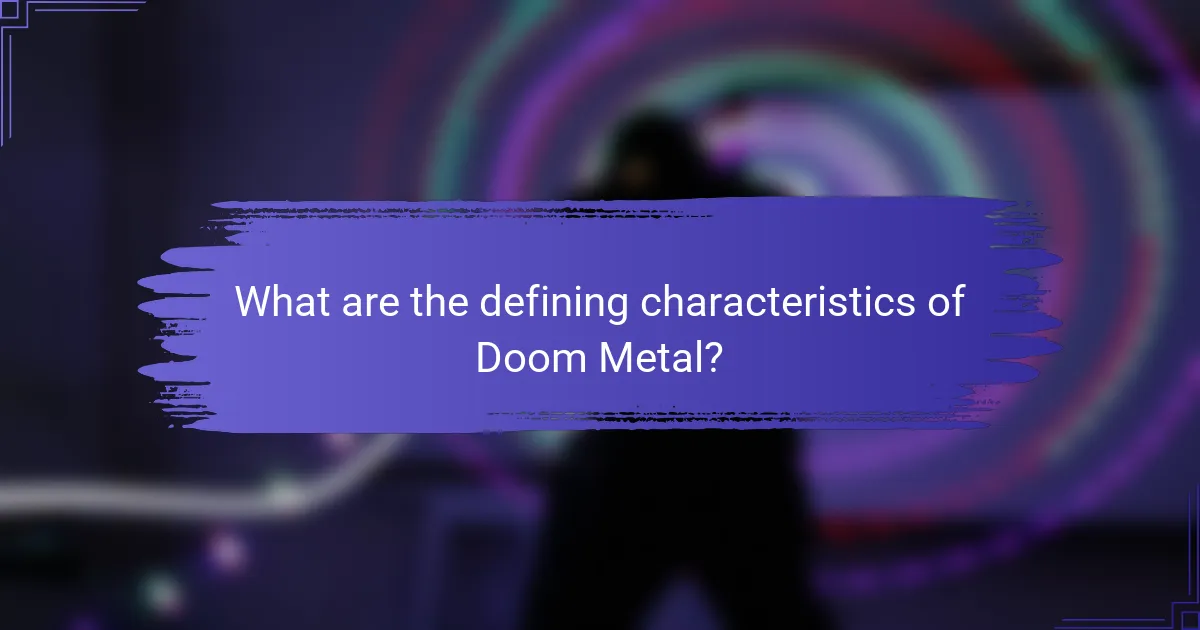
What are the defining characteristics of Doom Metal?
Doom Metal is characterized by slow tempos, heavy guitar riffs, and a dark atmosphere. Its roots trace back to the late 1960s and early 1970s, influenced by Black Sabbath. Unique attributes include themes of despair and existential dread, often conveyed through haunting vocals. Iconic albums like “Master of Reality” and “Doomsday” exemplify these defining traits. Doom Metal’s sound emphasizes a heavy, sludgy texture, creating an immersive listening experience.
How does tempo influence the sound of Doom Metal?
Tempo significantly influences the sound of Doom Metal by creating an atmosphere of heaviness and despair. Slow tempos, often ranging from 60 to 80 beats per minute, enhance the genre’s signature heaviness. This deliberate pacing allows for extended riffs and deep, resonant tones, contributing to a sense of foreboding. Additionally, varying the tempo within songs can evoke different emotional responses, with slower sections emphasizing melancholy and faster parts adding intensity. The interplay of tempo and rhythm is essential in shaping the overall sound and experience of Doom Metal.
What role do heavy riffs play in Doom Metal music?
Heavy riffs are central to Doom Metal, creating a slow, heavy sound that evokes a sense of darkness and despair. These riffs typically feature distorted guitars and are characterized by their low tunings and repetitive structures. This musical style draws from early Black Sabbath influences, emphasizing mood over speed. The unique attribute of heavy riffs in Doom Metal lies in their ability to convey emotional depth, often reflecting themes of existential dread and hopelessness. Iconic albums like “Doomsday for the Deceiver” by Flotsam and Jetsam exemplify this signature sound, showcasing how heavy riffs define the genre’s identity.
Why is lyrical content significant in Doom Metal?
Lyrical content is significant in Doom Metal as it enhances the genre’s themes of despair and existentialism. The lyrics often explore dark subjects such as death, suffering, and personal struggles, creating a profound emotional connection. This thematic depth is complemented by the slow, heavy instrumentation typical of Doom Metal, allowing for a reflective listening experience. Iconic albums like “Black Sabbath” and “Candlemass” exemplify how lyrics contribute to the overall atmosphere, reinforcing the genre’s identity and appeal.
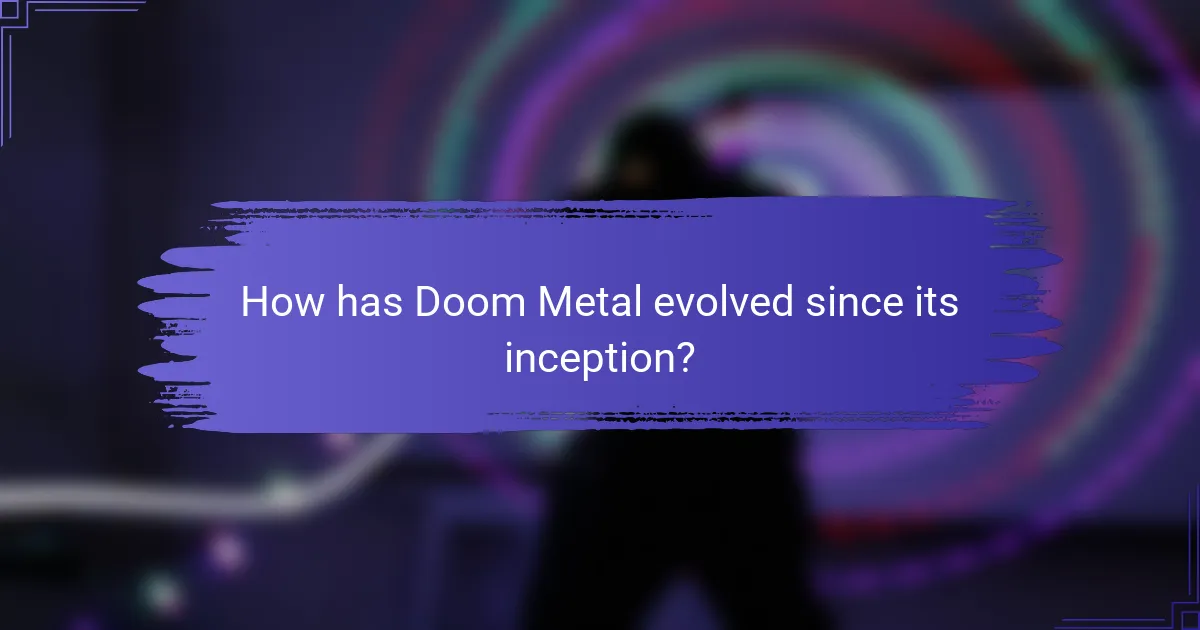
How has Doom Metal evolved since its inception?
Doom metal has evolved by incorporating diverse influences and expanding its thematic scope. Initially rooted in the heavy metal of the late 1960s and early 1970s, it emphasized slow tempos and dark themes. Over the decades, subgenres like funeral doom and stoner doom emerged, introducing unique attributes such as atmospheric elements and psychedelic influences. Iconic albums like Black Sabbath’s “Black Sabbath” and Electric Wizard’s “Dopethrone” illustrate this evolution. As a result, doom metal now features a broader array of sounds and lyrical themes, appealing to a wider audience while retaining its core identity.
Which bands were pivotal in the early development of Doom Metal?
Black Sabbath, Pentagram, and Candlemass were pivotal in the early development of Doom Metal. Black Sabbath’s slow, heavy riffs and dark themes laid the foundation. Pentagram contributed with their occult lyrics and heavy sound, while Candlemass refined the genre’s epic and melodic elements. These bands established the core characteristics and aesthetics that define Doom Metal today.
What influences from other genres shaped Doom Metal’s sound?
Doom Metal’s sound is influenced by genres like heavy metal, blues, and psychedelic rock. Heavy metal contributes to its aggressive riffs and powerful vocals. Blues adds emotional depth through slow tempos and expressive guitar solos. Psychedelic rock introduces atmospheric elements and experimental structures, enhancing Doom Metal’s dark and immersive qualities. These influences combine to create a unique sonic landscape characterized by heaviness and melancholy.
How did the 1990s underground scene impact Doom Metal’s trajectory?
The 1990s underground scene significantly shaped Doom Metal’s evolution by introducing diverse influences. Bands like My Dying Bride and Paradise Lost expanded the genre’s sound, incorporating elements of gothic and death metal. This era also fostered a DIY ethos, allowing independent labels to promote emerging talent. As a result, Doom Metal gained a broader audience while maintaining its distinct identity. The fusion of slower tempos and atmospheric elements during this time created iconic albums that defined the genre’s future trajectory.
![]()
Which iconic albums define the Doom Metal genre?
Iconic albums that define the Doom Metal genre include “Black Sabbath” by Black Sabbath, “Dopethrone” by Electric Wizard, “Holy Mountain” by Sleep, “Into the Void” by Black Sabbath, “The Dusk and Their Embrace” by Cradle of Filth, and “Dope Smoker” by Sleep. These albums showcase the genre’s heavy riffs, slow tempos, and dark themes, establishing a foundational sound. Each album contributes uniquely to the evolution of Doom Metal, influencing countless bands and subgenres.
What makes Black Sabbath’s “Master of Reality” a cornerstone album?
Black Sabbath’s “Master of Reality” is a cornerstone album due to its heavy sound and influence on doom metal. Released in 1971, it introduced slower tempos and darker themes, setting a template for future metal genres. The album features iconic tracks like “Sweet Leaf” and “Children of the Grave,” which showcase its unique blend of heaviness and melody. Its groundbreaking use of down-tuned guitars and powerful riffs established a new standard in rock music, making it a pivotal moment in the evolution of heavy metal.
How did “Dopethrone” by Electric Wizard redefine the genre?
“Dopethrone” by Electric Wizard redefined doom metal by amplifying its heaviness and embracing a sludgy sound. This album introduced a darker atmosphere and a more psychedelic approach, influencing countless bands. Its themes of despair and occultism deepened the genre’s emotional impact. The distinct production style, characterized by fuzz-laden guitars and slow tempos, became a benchmark for future doom metal albums.
Which contemporary albums are shaping the future of Doom Metal?
Contemporary albums shaping the future of Doom Metal include “The Dusk in Us” by Converge, “The End of Six Thousand Years” by Ahab, and “Eternal Return” by Pallbearer. These albums showcase innovative soundscapes, blending traditional Doom elements with modern influences. “The Dusk in Us” features intense emotional depth, while “The End of Six Thousand Years” incorporates orchestral arrangements. “Eternal Return” emphasizes atmospheric textures, pushing the genre’s boundaries. Collectively, these works highlight the evolution of Doom Metal, emphasizing its adaptability and relevance in today’s music scene.
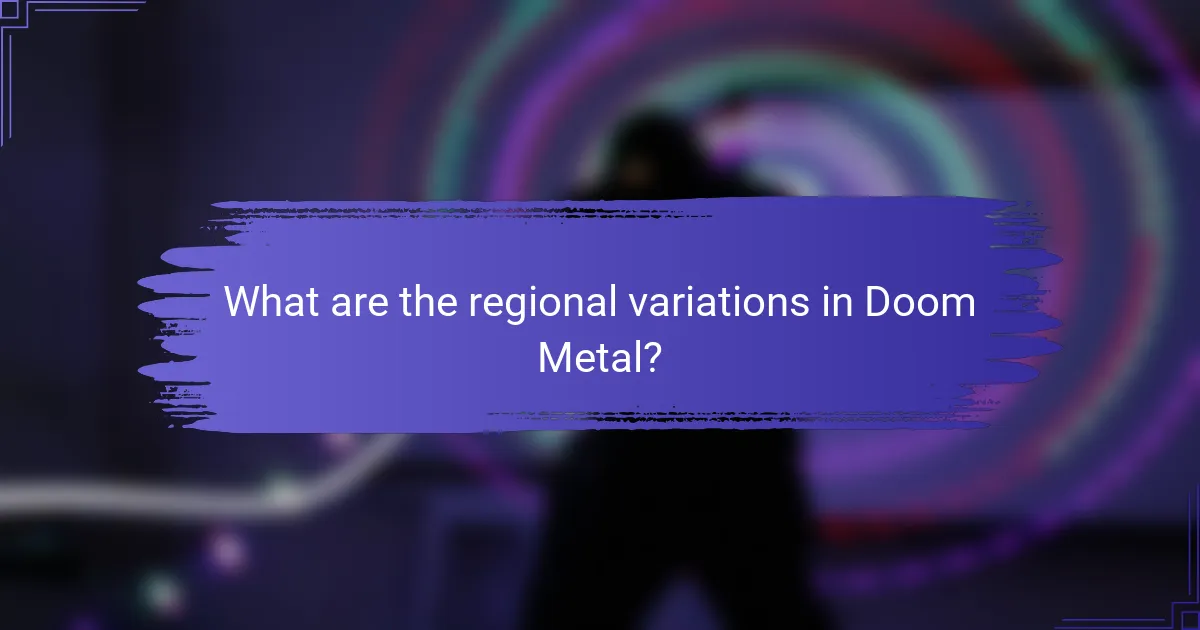
What are the regional variations in Doom Metal?
Doom Metal varies significantly across regions, influenced by local culture and musical trends. In the United States, it often features heavy, sludgy riffs and dark themes, exemplified by bands like Sleep and Electric Wizard. European Doom Metal, particularly from the UK and Scandinavia, tends to incorporate more melodic elements, with bands such as My Dying Bride and Candlemass focusing on atmospheric and symphonic qualities.
In South America, Doom Metal is characterized by its incorporation of traditional rhythms and local musical styles, resulting in a unique fusion. Notable bands include Pentagram from Chile, which blends traditional metal with regional influences. Asian Doom Metal, particularly from countries like Japan, often showcases experimental sounds and influences from other genres, leading to innovative interpretations of the style.
Each region’s unique attributes contribute to the diversity within Doom Metal, making it a rich and varied genre.
How does the UK scene differ from the US Doom Metal scene?
The UK Doom Metal scene is characterized by its atmospheric sound and emphasis on lyrical themes, while the US scene often features heavier riffs and a more aggressive style. UK bands like Electric Wizard and My Dying Bride focus on creating a haunting ambiance, drawing from gothic and progressive influences. In contrast, US bands such as Sleep and Crowbar lean towards sludgier tones, incorporating elements of stoner rock. The cultural contexts also differ; UK Doom often reflects a sense of melancholy and introspection, whereas US Doom tends to channel raw energy and power. This divergence creates distinct identities within the broader Doom Metal genre.
What unique sounds emerge from the Scandinavian Doom Metal bands?
Scandinavian Doom Metal bands uniquely blend heavy, slow tempos with atmospheric elements. They often incorporate haunting melodies, deep growls, and clean vocals, creating a rich soundscape. Bands like Candlemass and Katatonia exemplify this style, using intricate guitar work and emotional lyrics. Their sound is characterized by a mix of traditional doom riffs and influences from Nordic folklore, adding a distinct cultural depth.
Which festivals celebrate Doom Metal culture globally?
Doom Metal culture is celebrated globally through various festivals. Notable events include Roadburn Festival in the Netherlands, Hellfest in France, and Maryland Doom Fest in the United States. Each festival showcases iconic bands, promotes the genre, and fosters community among fans. Roadburn emphasizes experimental sounds, while Hellfest features a diverse lineup including mainstream and underground acts. Maryland Doom Fest focuses on local talent and emerging bands, highlighting the genre’s roots. These festivals reflect Doom Metal’s rich history and cultural significance.
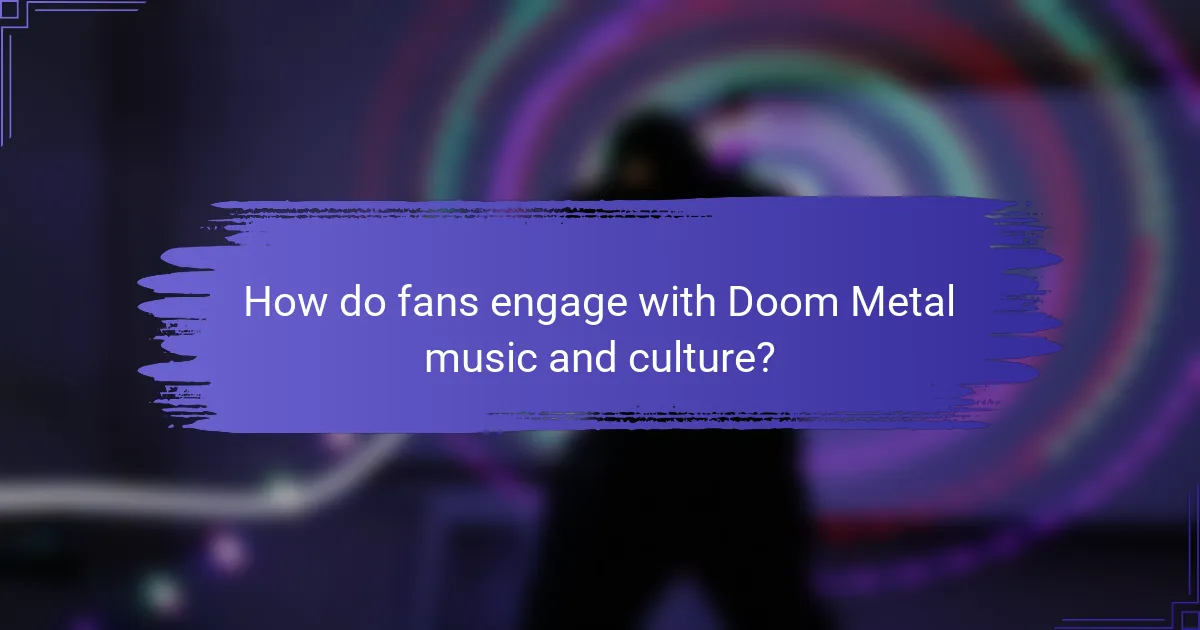
How do fans engage with Doom Metal music and culture?
Fans engage with Doom Metal music and culture through active participation in live shows, online communities, and merchandise support. They appreciate the genre’s heavy sound and lyrical themes, often sharing their experiences on social media.
Doom Metal’s history and unique attributes, such as its slow tempos and dark atmosphere, resonate deeply with fans. Iconic albums like “Black Sabbath” and “Dopethrone” serve as cultural touchstones, fostering discussions and connections among listeners.
Additionally, fans often create and share artwork, cover songs, and playlists, contributing to a vibrant community. This engagement reflects a shared passion for the genre and its evolution over time.
What are the common themes in Doom Metal fan communities?
Doom Metal fan communities often share themes of introspection, existentialism, and a deep appreciation for the genre’s slow, heavy sound. Fans engage in discussions about lyrical depth and the emotional weight of the music. Shared interests include iconic albums and the influence of classic bands like Black Sabbath and Candlemass. Community activities often involve attending live shows, participating in online forums, and exploring sub-genres. The unique attribute of Doom Metal fans is their commitment to the genre’s darker themes, reflecting a rare emotional connection to the music.
How do live performances enhance the Doom Metal experience?
Live performances significantly enhance the Doom Metal experience by creating an immersive atmosphere. The heavy riffs and slow tempos resonate deeply in a live setting, amplifying emotional intensity. Fans connect with the music and each other, fostering a sense of community. Unique visual elements, such as stage lighting and thematic imagery, further enrich the experience. Additionally, the spontaneity of live performances introduces rare moments that cannot be replicated in studio recordings.
What role does merchandise play in Doom Metal fandom?
Merchandise plays a crucial role in Doom Metal fandom by fostering community and identity. Fans express their passion through band-related items like shirts, vinyl, and posters. These items serve as symbols of allegiance to the genre and its artists. Unique merchandise often features artwork and themes that resonate with the dark, atmospheric qualities of Doom Metal. Additionally, exclusive items from concerts or limited editions enhance the fan experience, creating a sense of belonging and shared culture among enthusiasts.
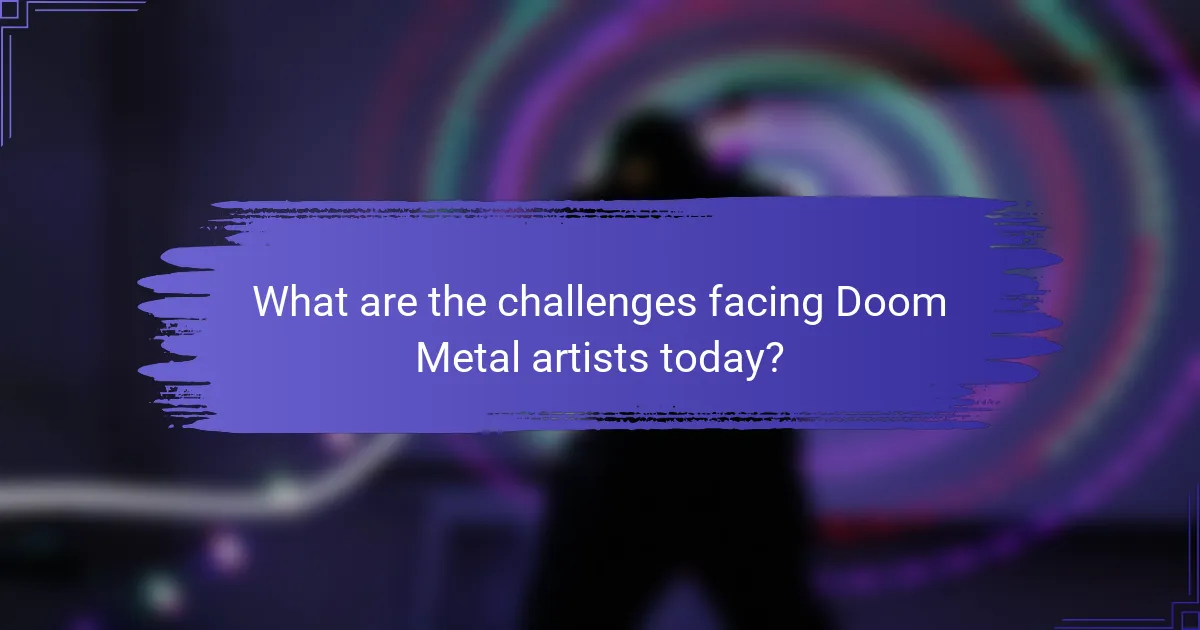
What are the challenges facing Doom Metal artists today?
Doom Metal artists face numerous challenges today, including maintaining originality, navigating a saturated market, and adapting to digital platforms. As the genre evolves, artists struggle to stand out while staying true to its roots. Moreover, the impact of streaming services has altered traditional revenue streams, necessitating new strategies for financial sustainability. The community’s tight-knit nature can also pressure artists to conform to established norms, hindering innovation.
How do streaming platforms impact the reach of Doom Metal bands?
Streaming platforms significantly enhance the reach of Doom Metal bands by providing global accessibility and exposure. These platforms allow niche genres like Doom Metal to reach wider audiences who may not have access to traditional music distribution channels.
For instance, platforms such as Spotify and Bandcamp enable listeners to discover bands through curated playlists and recommendations, increasing their fan base. The data shows that streaming has led to a rise in the number of Doom Metal playlists, which helps in promoting lesser-known bands alongside established ones.
Moreover, streaming services often feature user-generated content, such as reviews and covers, that can further elevate a band’s visibility. This democratization of music distribution empowers Doom Metal artists to connect directly with fans, fostering a dedicated community around the genre.
In summary, streaming platforms are crucial for Doom Metal bands, enhancing their reach and enabling them to thrive in a competitive music landscape.
What are the financial realities for independent Doom Metal musicians?
Independent Doom Metal musicians often face financial challenges due to niche market dynamics. Revenues primarily stem from album sales, merchandise, and live performances, but profits are typically low.
The average album sale for independent artists can yield around $1 to $3 per unit, significantly less than major label artists. Merchandise sales can provide better margins, often generating $5 to $20 per item sold. Live performances may offer the most substantial income, but expenses such as travel and venue fees can diminish earnings.
Crowdfunding and digital platforms have emerged as vital financial resources, allowing artists to connect directly with fans. Despite these avenues, many independent Doom Metal musicians struggle to achieve sustainable income, highlighting the unique financial realities of this genre.
Which trends are emerging in the production of Doom Metal music?
Emerging trends in the production of Doom Metal music include the integration of atmospheric elements, increased use of digital production techniques, and collaborations with other genres. Artists are exploring themes of existentialism and personal struggle, creating a more introspective sound. The rise of independent labels is promoting diverse voices within the genre. Additionally, live performances are evolving with immersive experiences that enhance the heavy soundscapes. These trends reflect a dynamic evolution in Doom Metal, pushing creative boundaries.
What strategies can Doom Metal bands use to build a sustainable career?
Doom Metal bands can build a sustainable career by focusing on strategic branding, consistent content creation, and audience engagement. Establishing a strong identity helps differentiate bands in a niche market. Regularly releasing music and engaging with fans through social media fosters loyalty and community. Collaborating with other artists expands reach and introduces new listeners. Additionally, playing live shows and participating in festivals enhances visibility and generates income. Leveraging merchandise sales can provide financial stability, while maintaining quality production ensures a professional image.
